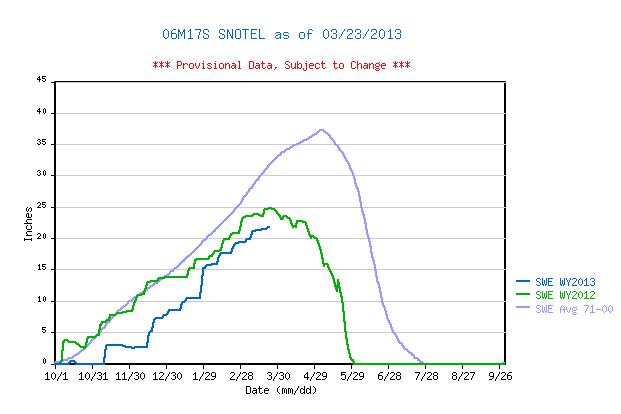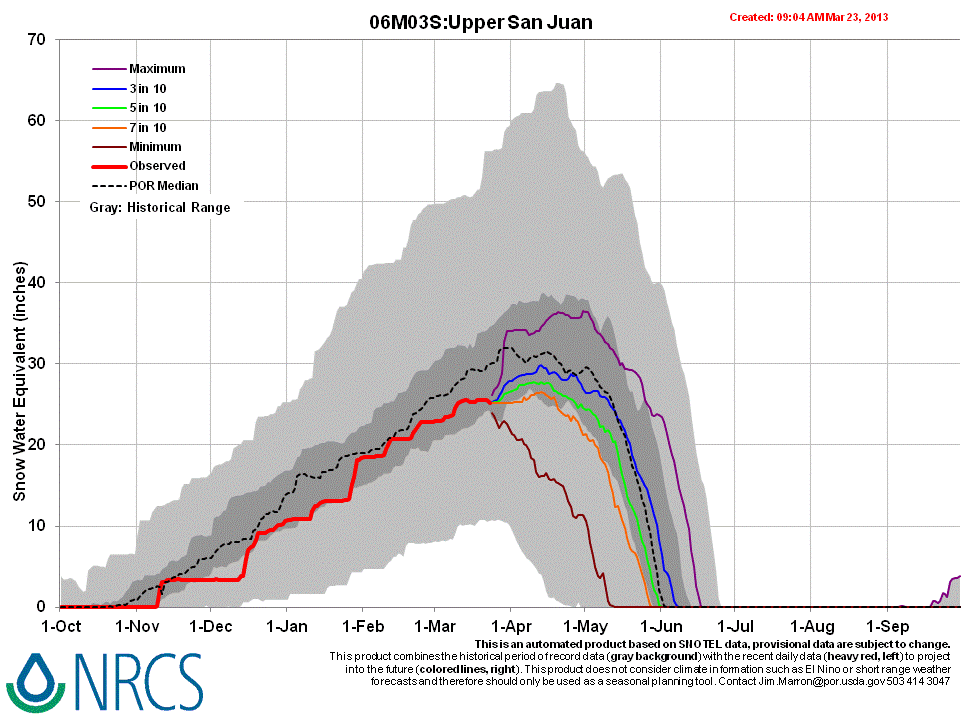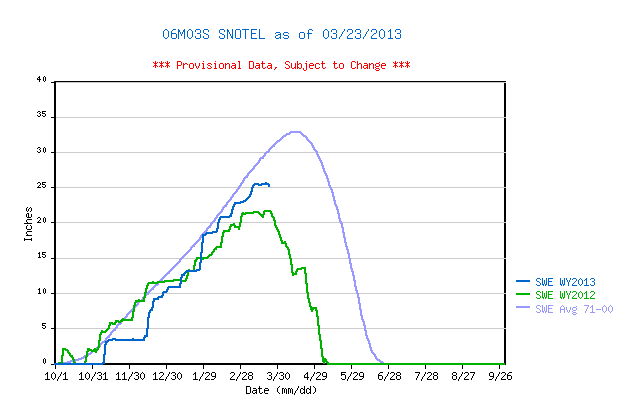 CODOS Update for Wolf Creek Pass site:
CODOS Update for Wolf Creek Pass site:
visited March 23, 2013
Summary | Snowpack | Melt Rate | Forecast
Summary
This field session at the Wolf Creek Pass CODOS site, our first of the WY 2013 season, found somewhat more SWE than observed a year earlier, in slightly deeper snowcover. A fresh dust layer was readily observed at/in the snowpack surface (event D5), and three additional dust layers, likely including event D2, were clearly evident within the snowpack. The snowpack still retains some cold content and will require additional warming to become isothermal, but dust layer D5 will accelerate snowpack warming in coming days. Our CODOS Wolf Creek Pass snow profile contained slightly more total SWE than the nearby Wolf Creek Summit Snotel site was reporting that day, and some 2” less SWE than the Upper San Juan Snotel. A very rapid die-off of subalpine fir trees is underway at Wolf Creek Pass, and adjacent to the CODOS site.
SnowPack Discussion
Total snow depth in our March 23, 2013 Wolf Creek Pass CODOS site snow profile was 68”, 5” more than observed at the site a year before, on March 17, 2012. Total SWE in this profile was 23.2”, or 1.3” more SWE than measured a year earlier. Mean density of this snowpack was 344 kg/m3 (34.4% water content), virtually identical to the 348 kg/m3 mean density measured a year before, and the densest “dry” snowpack observed on this circuit of CODOS sites (the “wet” McClure Pass snowpack was denser, at 371 kg/m3).
Several significant melt-freeze episodes had occurred in the snowpack at the CODOS site earlier in March, and in February (associated with a thick dust layer). Thick layers of clear ice were present mid-pack, and most of the near-surface was composed of laminated ice layers and melt-freeze polycrystal crusts. However, on March 23 the snowpack was once again completely dry and retained significant cold content. Mean snowpack temperature in this profile was -2.8° C, as compared to -0.7° C a year earlier.
Dust-on-snow layer D5-WY2013 (March 21) was faintly evident within the thin layer of new new snow at the surface in our CODOS snow profile but was dramatically concentrated by wind at other nearby locations. Three additional dust layers were also observed at various depths within the snowpack, including a thick band of weakly brown tinged snow that does not correspond to any dust event recorded this season at Senator Beck Basin. Dust layers corresponding to events D2 (likely) and D1 (clearly) were in evidence. Just 3.7” of overlying SWE covered the presumed D2 (February 8) layer, versus the 6” gain in SWE recorded between February 8 and March 23 at the nearby, well-shaded Wolf Creek Summit Snotel; some upper snowpack SWE at the CODOS site may have relocated to the middle of the snowpack during intense surface melt episodes, as evidenced by the ice layers below D2.
Wolf Creek Summit Snotel data for WY 2013 places current SWE near the top of the lower quartile of SWE values for the period of record but somewhat below the same-date values recorded in WY 2012. The Upper San Juan Snotel, just a few miles west, currently reports SWE values closer to but still below the median for the period of record, and higher than values reported in late March 2012. This difference is difficult to explain, given that the Upper San Juan Snotel site is lower than and much more exposed to solar radiation than the Wolf Creek Summit site.
A small group of subalpine fir trees adjoin the CODOS snow pit site. These and subalpine fir throughout the Wolf Creek Pass locale have recently died and are now dropping their needles and branches, contaminating the snowpack in the process (see photo). This snow profile was performed at a distance from the dying trees and minimal vegetation debris was observed in the snowpack.
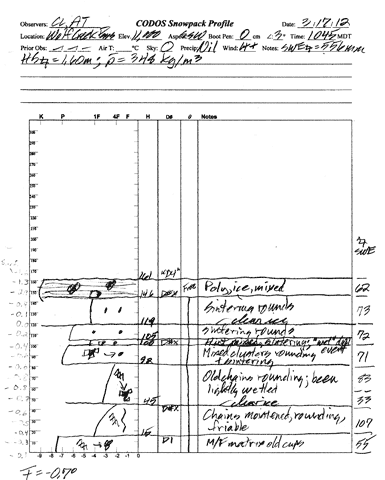 |
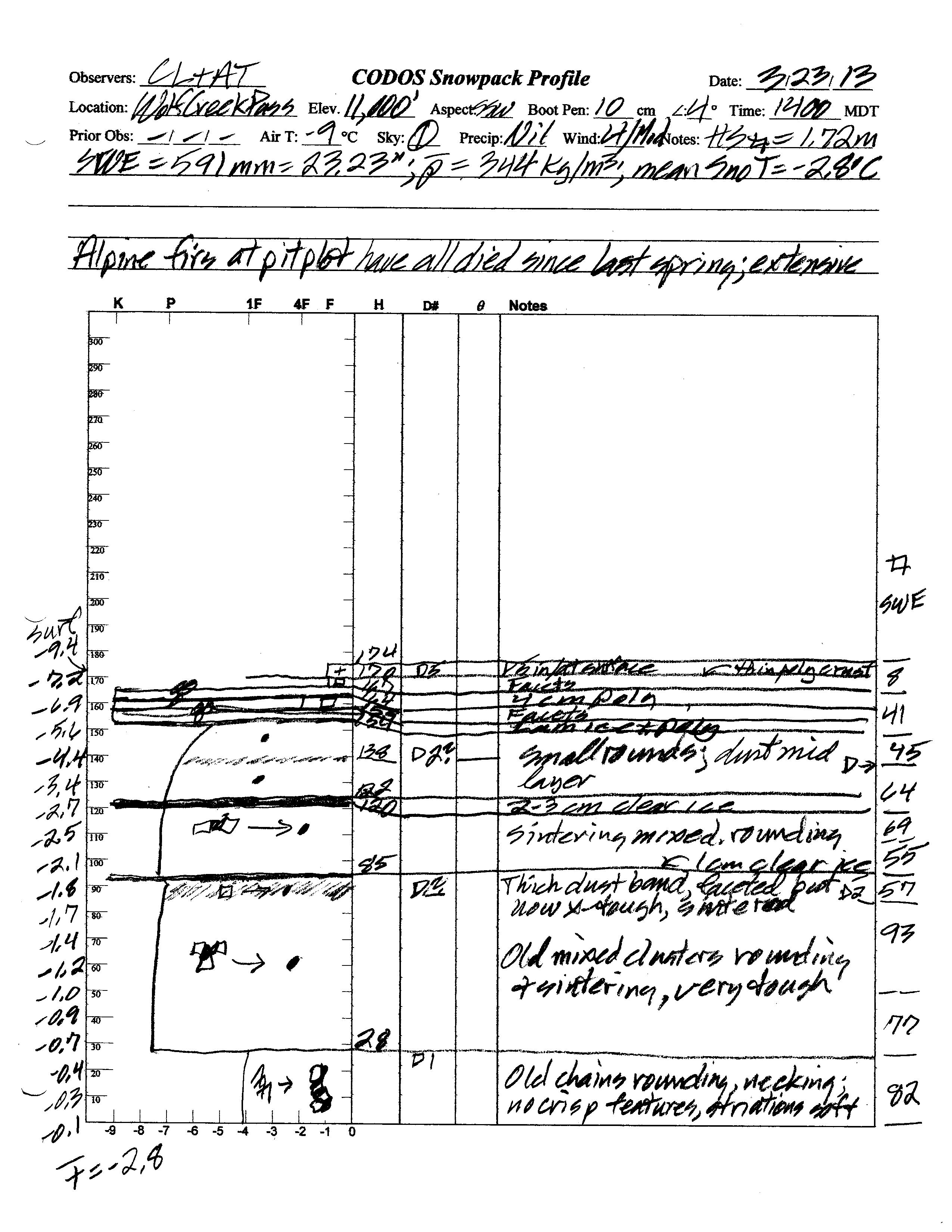 |
|
| 2012 Pit Profile | 2013 Pit Profile |
Melt Rate
The Wolf Creek Summit Snotel site continues to accumulate SWE and reports no significant losses of SWE, to-date. Upper San Juan Snotel does show a recent small decline in SWE, even as snow depth was increasing. Several episodes of surface snowmelt had occurred in the snowpack at the slightly southwest-facing CODOS snow profile site but we observed no indications that free water had yet percolated to the bottom of and exited the snowpack, as runoff. Upon renewed surface melt conditions, cold snow temperatures within the snowpack will still refreeze percolating free water, as ice layers and “flow fingers”. Nonetheless, that process, enhanced by dust layer D5 (and eventually by the merger of D5 with D2), will consume cold content and accelerate snowpack warming. At the lowest snow covered elevations, on both sides of Wolf Creek Pass, solar energy absorbed by D5 (perhaps already merged with D2) will result in accelerating snowmelt runoff (or absorption into soils) and snowcover ablation, to “snow all gone” (SAG).
Forecast
The National Weather Service anticipates mostly sunny weather in the southern San Juan Mountains for most of the remainder of March, perhaps even a chance for rain at pass elevations, and seasonably warm temperatures in the 40’s. Given the extensive and substantial D5 dust-on-snow layer at/near the snowpack surface, and the minimal accumulations of new snow since our site visit, the Wolf Creek Pass CODOS site is already experiencing reduced snow albedo and additional, dust-enhanced absorption of solar energy. Initially, that extra increment of absorbed solar energy will accelerate snowpack warming, as infiltrating melt water forces this snowpack toward isothermal temperatures, at 0° C throughout. Once isothermal, and as/when layers D5 and D2 merge and remain exposed, snowmelt runoff (or absorption by soils) will commence and snowpack ablation will accelerate. Those snowmelt processes are more advanced, in much thinner snowcover, at the lowest snowcovered elevations in both the upper Rio Grande and San Juan River watersheds.
As of March 23, 2013 only NRCS’s “maximum” projection of future snowpack accumulation would result in peak SWE at/above the median at either the Wolf Creek Summit or Upper San Juan Snotel sites. NRCS projects between a 3 in 10 chance and a 5 in 10 chance that complete snowcover ablation (snow all gone, or SAG) will occur near the median date at those sites, but higher probabilities that SAG will be earlier than the median date. Those projections are made based on historical snowpack behavior but without direct, season-specific estimations of dust enhanced snowmelt rates.


